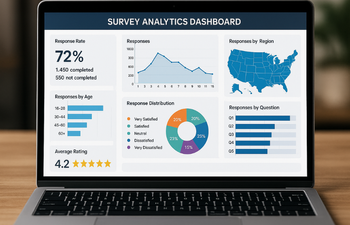Conducting Surveys for Nonprofits: Best Practices on a Budget
Discover how nonprofits can conduct effective surveys on a tight budget with these practical strategies.

Introduction
Surveys are one of the most powerful tools nonprofits can use to stay connected to their community, understand impact, and gather insights to improve operations. But let’s face it, resources are often tight. Conducting high-quality surveys without breaking the bank is a common challenge.
Whether you're running a local food pantry or a global advocacy campaign, collecting feedback from donors, volunteers, and beneficiaries is critical. With the right approach, even the most resource-constrained organizations can run impactful surveys.
Why Surveys Matter for Nonprofits
Surveys provide a structured method for nonprofits to:
- Evaluate program effectiveness.
- Identify unmet community needs.
- Improve donor retention strategies.
- Build trust through transparency.
- Justify funding and report outcomes.
They serve as a direct line to stakeholders, if you know how to listen.
Common Challenges in Nonprofit Surveying
Nonprofits typically face these roadblocks:
- 1Limited financial and staff resources.
- 2Difficulty accessing target populations.
- 3Low response rates.
- 4Lack of technical tools and expertise.
The good news? These challenges can be overcome with strategic planning and a few cost-effective tools.
Setting Clear Goals Before You Survey
A successful survey starts with a clear objective. Are you trying to understand volunteer satisfaction? Assess the impact of a program? Or gather ideas for new services?
By focusing on one or two specific goals, you avoid the common pitfall of trying to ask everything in one go, which only results in lower quality data and survey fatigue.
Identifying Your Target Audience
Knowing who you need responses from will help you tailor both the survey design and distribution. Nonprofits typically survey:
- Donors
- Volunteers
- Beneficiaries
- Community members
- Staff and board members
Each audience will require different language, platforms, and question types.
Choosing the Right Survey Tools on a Budget
Not all survey platforms come with a hefty price tag. In fact, many offer free tiers that are more than enough for small nonprofits.
Crafting Effective Survey Questions
Keep these golden rules in mind:
- Avoid leading questions.
- Use simple, jargon-free language.
- Mix multiple-choice with open-ended responses.
- Limit to 10-12 questions for higher completion rates.
Timing and Frequency
Launching a survey at the wrong time can mean poor response rates. The best times are often:
- Immediately after a service has been delivered.
- After an event or campaign.
- During key fundraising seasons (for donor surveys).
Quarterly or annual surveys provide a rhythm without being overwhelming.
Strategies to Boost Survey Participation
Getting people to actually complete your survey is half the battle. Consider these tactics:
- Offer small incentives like raffles or gift cards.
- Keep surveys short and mobile-friendly.
- Personalize your outreach messages.
- Share how previous survey results made an impact.
- Use a clear and compelling subject line in email invites.
Using Social Media to Promote Surveys
Social media platforms are a free megaphone. Use visuals, polls, and direct survey links on platforms like:
- Facebook (great for community groups)
- Instagram Stories (use poll stickers)
- Twitter/X (pin a tweet with the survey)
- LinkedIn (for professional networks and donor feedback)
Collaborating With Partners and Volunteers
Partner with universities, community groups, or other nonprofits to expand reach. Interns and volunteers studying data science or communications can be invaluable assets in survey design and analysis.
For more creative ways to use surveys, see our post on Creative Ways to Use Online Surveys Beyond Customer Feedback.
Ethical Considerations
When collecting data:
- Get consent when needed.
- Clearly state how the data will be used.
- Keep personal responses confidential.
Being transparent builds credibility and trust.
Analyzing Survey Results Without Fancy Software
Free tools like Google Sheets or Excel work just fine for most analysis. Focus on:
- Key trends
- Frequent words in open-ended answers
- Percentages and charts
Visualization helps translate raw data into actionable insights.
Sharing What You Learn
Always close the loop. Tell respondents what you learned and what changes you’ll make. This encourages future participation and strengthens your community relationships.
Budgeting for Surveys: Where to Save
Here's how to stretch every dollar:
- Use free or discounted nonprofit software.
- Print paper surveys only when necessary.
- Ask local businesses to sponsor small incentives.
- Train existing staff rather than hiring consultants.
Case Study: Small Nonprofit, Big Impact
One small nonprofit in rural Oregon surveyed its food pantry users using Google Forms on borrowed tablets. With just 8 questions and a $25 grocery card raffle, they got a 60% response rate. They discovered 40% of respondents lacked transportation and added mobile delivery, doubling their reach in 3 months.
Mistakes to Avoid
Steer clear of:
- Vague or overly technical questions.
- Ignoring demographics that matter.
- Surveying too often without acting on feedback.
- Failing to test your survey first.
Leveraging Survey Data for Grants and Fundraising
Well-structured survey data can strengthen grant applications by:
- Providing community-driven evidence of need.
- Showing measurable outcomes.
- Demonstrating impact and community support.
If you're looking to turn survey data into actionable insights, check out our guide on From Survey Data to Actionable Insights: A Step-by-Step Guide.
Combining Surveys with Other Data Sources
Surveys offer perception data, but you can compare them with:
- Web analytics
- CRM reports
- Donation patterns
This triangulation improves decision-making.
Going Beyond the Basics
For larger nonprofits or growing organizations, consider investing in tools like Airtable or Tableau Public (both have free options for nonprofits) to build dashboards and dynamic visualizations.
Conducting Surveys for Nonprofits: Best Practices on a Budget
Conducting surveys for nonprofits doesn’t have to be expensive. With smart planning, the right tools, and a little creativity, even the smallest nonprofit can gain valuable insights from their community. Surveys not only guide internal decisions, they help tell your story, attract funding, and validate your mission.
Frequently Asked Questions
Find answers to the most common questions about this topic
Nonprofits can use free tools like Google Forms, leverage social media, and partner with volunteers or local institutions for support.
Feedback surveys, impact assessments, and community needs assessments are most useful for nonprofits.
Depending on the program, quarterly or annual surveys work well, with smaller check-ins in between.
Avoid long or confusing surveys, poor targeting, and not analyzing results properly.
Yes, platforms like Facebook, Instagram, and LinkedIn are great for distributing surveys and gathering responses.
They should analyze the results, communicate findings to stakeholders, and take action to improve programs or services.








